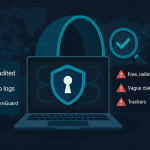
Introduction
In today’s digital landscape, cyber threats are evolving at an unprecedented pace. Traditional security measures, once effective, are now struggling to keep up with sophisticated attacks. Enter Artificial Intelligence (AI) — a transformative force reshaping cybersecurity by enabling faster, smarter, and more proactive threat detection and response.
This blog explores how AI-driven threat detection is revolutionizing cybersecurity in 2025, offering insights into its benefits, real-world applications, and future implications.
The Evolving Cyber Threat Landscape
Cybercriminals are leveraging advanced technologies to launch more complex and targeted attacks. From AI-generated phishing emails to adaptive malware that evades traditional defenses, the threat landscape is becoming increasingly dynamic. Organizations face challenges such as:Capitol Tech
- Volume of Threats: The sheer number of daily cyber threats overwhelms traditional security systems.
- Speed of Attacks: Automated attacks can infiltrate systems within seconds, leaving little time for manual intervention.
- Sophistication: Modern threats often involve multi-vector attacks that are difficult to detect using conventional methods.
How AI Enhances Threat Detection
AI brings a paradigm shift in cybersecurity by introducing capabilities that surpass human limitations:
1. Real-Time Monitoring and Analysis
AI systems can continuously monitor network traffic, user behavior, and system activities to detect anomalies in real-time. For instance, if an employee’s account suddenly attempts to access large volumes of sensitive data at odd hours, AI can flag this behavior for immediate investigation.
2. Predictive Threat Intelligence
By analyzing historical data and identifying patterns, AI can predict potential threats before they materialize. This proactive approach allows organizations to strengthen defenses against anticipated attacks.
3. Automated Response Mechanisms
Upon detecting a threat, AI can initiate automated responses such as isolating affected systems, blocking malicious IP addresses, or alerting security teams, thereby reducing response times and mitigating damage.
Real-World Applications
Several organizations have successfully integrated AI into their cybersecurity frameworks:
- Financial Institutions: Banks utilize AI to detect fraudulent transactions by analyzing spending patterns and flagging anomalies.
- Healthcare Providers: Hospitals employ AI to safeguard patient data by monitoring access logs and detecting unauthorized access attempts.
- E-commerce Platforms: Online retailers use AI to identify and prevent bot-driven attacks aimed at compromising customer accounts.
Benefits of AI-Driven Threat Detection
Implementing AI in cybersecurity offers numerous advantages:
- Enhanced Accuracy: AI reduces false positives by accurately distinguishing between legitimate activities and potential threats.
- Scalability: AI systems can handle vast amounts of data, making them suitable for organizations of all sizes.
- Cost Efficiency: By automating routine security tasks, AI allows security teams to focus on strategic initiatives, optimizing resource allocation.
Challenges and Considerations
While AI offers significant benefits, organizations must address certain challenges:
- Data Privacy: Ensuring that AI systems comply with data protection regulations is crucial.
- Integration Complexity: Integrating AI into existing security infrastructures may require substantial effort and expertise.
- Adversarial AI: Cybercriminals may also use AI to develop more sophisticated attacks, necessitating continuous advancement in defensive AI capabilities.
The Future of AI in Cybersecurity
Looking ahead, AI is poised to become an integral component of cybersecurity strategies:
- Self-Healing Systems: AI will enable systems that can automatically detect and repair vulnerabilities without human intervention.
- Collaborative Defense Networks: Organizations may share AI-driven threat intelligence to collectively strengthen defenses against widespread threats.
- Enhanced User Authentication: AI will improve authentication methods by analyzing behavioral biometrics, reducing reliance on traditional passwords.
Conclusion
In 2025, AI-driven threat detection stands as a cornerstone of effective cybersecurity. By embracing AI technologies, organizations can proactively defend against evolving threats, safeguard sensitive data, and ensure the integrity of their digital operations.
As cyber threats continue to advance, integrating AI into cybersecurity frameworks is not just advantageous—it’s imperative.



